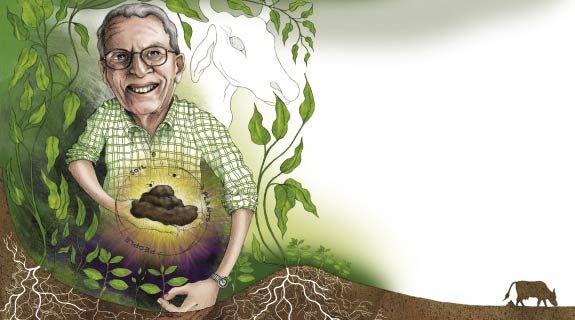Kiwi gardener Peter Proctor never expected to spend his seventies in India, transforming the country’s farming practices while being fêted like a rock star. Barbara Sumner Burstyn talks to the international superstar of biodynamics
Kiwi gardener Peter Proctor never expected to spend his seventies in India, transforming the country’s farming practices while being fêted like a rock star. Barbara Sumner Burstyn talks to the international superstar of biodynamics
Illustration by Jo Thapa
It’s a chilly Hawkes Bay morning, and I’m standing in a garden in Waimarama next to a pile of cow dung. As others arrive, wrapped up against the early morning chill, it’s easy to spot the odd man out.
For a start he’s elderly, with sparse hair and trousers tucked into well-worn freshly shined work boots. He seems impervious to the cold and exudes a sense of excitement, especially when he spies the cow dung. The rest of us look as if we need a coffee.
Before we can greet each other he is poking about in the dung, checking its quality, balling it in the palm of his hand. As a form of greeting he begins passing out handfuls of cow faeces to the surprised group. It’s obvious he wants us to smell the stuff, to squish it between our cold fingers. We sort of laugh and I’m sure there are others who are also thinking about the cafe down the road with its warm croissants.
Our instructor isn’t one of them. This is Peter Proctor—biodynamic gardener, elderly gent, opera fanatic, teacher and author—in his element.
Recently returned from a three-year stint in India, the 79-year-old is a dynamo. Today, he’s leading a community compost-making class. There is no one in New Zealand more qualified in biodynamic practices than Peter, and I wonder if the participants realise they have a genuine local hero standing in front of them. Certainly, they would be surprised to learn that in India he is treated like a rock star.
Every day was a surprise when I travelled around India with Peter in 2006 while filming a documentary on biodynamic practices, One Man, One Cow, One Planet (see box, left, for more on biodynamics). Everywhere he goes, with his glass eye and no-nonsense manner, he is fêted by young farmers—even in the most remote rural backwater. It’s not clear how word of his visits spreads, but every time we stopped by a deserted field to look at the conditions of the soil, motorcycles would pull up, each loaded with three or more people who had come to see and talk to him.
Sharing a quiet meal was impossible. One minute we’re eating the best dosa on the planet; the next, a queue has formed, snaking from the table out the door. Farmers bring their cell phones and squat beside Peter to show him pictures of their compost heaps. In halting English, always the same questions: Is the compost too dry? Is there enough green material? How long should it be left? And always Peter exudes the same calm, unhurried confidence and patience.
It is this attitude that has seen tens of thousands of Indian farmers give up their chemical farming and turn to biodynamics.
Returning to New Zealand this year, at the advice of his doctor, must have been difficult. Suddenly, he’s back to making a much smaller impact. But Peter brushes off that notion. For him, ten people in a compost-making class represent success.
Sacred cows
What makes one man so driven to share his knowledge that he’ll spend his retirement in the heat and dust of India relentlessly teaching people how to grow food biodynamically? And then return to his home country and, on the eve of his 80th birthday, get up on a frosty morning to teach compost-making?
Conviction. Peter believes, as Gandhi did, that each of us has to be the change we want to see in the world. To achieve that change, Peter is formidably focused. For him, an all-organic India or New Zealand is not impossible. But instead of concentrating on politics, he keeps his hands in the soil as if all the answers to the world’s problems are contained there … and in the cows, of course.
Hindus believe that six million gods reside on the body of a cow—every hair is sacred. Peter is careful to attribute his success in India to the people’s understanding of the role of the cow in the development of humankind.
India is suffering from incredible soil damage courtesy of the 1970’s so-called ‘green revolution’, when pesticides and herbicides were introduced en masse to the continent. “This was supposed to alleviate world hunger,” explains Peter. “Instead the massive chemical inputs destroyed millennia of balanced mixed cropping, soil and water tables, communities and individuals alike.”
More than 60 percent of people in India still live close to this soil. For them, the devastation is obvious and acute.
In New Zealand, with our sparse population and relatively little pressure on natural resources, we have yet to really notice how chemical and industrial farming practices are damaging our most precious resources.
“When you take an answer like this to India, the people get it immediately. They need no convincing. They are living with the corporate destruction of their natural world every day. But try convincing New Zealanders that we’re causing irreparable damage to our ecosystems and our young people, and you meet a lot of resistance.”
One-eyed and single-minded
So how did this ordinary New Zealander become a teacher many compare to Gandhi?
“I got hit in the head by a stone when I was ploughing,” Peter says casually. “I think I had to lose an eye to really see how my life should go.”
Up to that point Peter had been a farmer, working at Hohepa Homes, the Steiner-based caring community beside the sea in Hawkes Bay’s Clive. There, he milked cows and worked alongside the Down’s Syndrome residents and a handful of farm and special needs workers.
After his accident Peter found he was unable to farm at the same rigorous pace. He was already into his sixties; most men would have considered retirement. Peter is still surprised at the turn his life took—a chance meeting with an Indian farmer, which led to an invitation to talk to the professors of agriculture at the Swaminathan Institute in Chennai in 1993.
“I slowly began to realise that after four decades of practical work and observation I had this huge store of knowledge on how to grow food sustainably, and that had value, beyond the daily tasks of running the farm.”
Back at the compost-making class, the sun has warmed the group and no one’s thinking of coffee now. Instead, Peter’s fascination with worms and rich soil, compost and cosmic forces has been transferred to the group. Now we all understand a little better how simple and elemental life can be—how the basic premise that healthy soil makes healthy plants makes healthy people could just be the key to life.
Peter’s dream is a world of small, connected communities, self-reliant and interdependent. It is the exact opposite of globalisation, an antidote to the corporate agenda of stripping intrinsic and long-term value from the land in return for short-term profit.
Somehow Peter manages to impart all these concepts while intent on the creation of the perfect compost heap. He has the unique ability to be totally in the present. Whether travelling with him in India or watching him convince urban gardeners to play with cow dung, it’s as if the rest of world does not exist.
It is this focus on being the change he wants to see in the world, right here and right now, that makes Peter unique. In an age of multitasking Peter is a committed single-tasker, bringing all of himself to each moment, to each person he meets, to each plant he nurtures.
As we begin layering green material with dry, adding a little water, some fresh cow dung and sprinkling in the preparations, I notice we’ve all lost our cow dung yuck-factor. Suddenly it’s a life-giving product, something to treasure. Context is everything.
Woo-wooed by wine

There are biodynamic wineries all over New Zealand: Pyramid Valley Vineyards, Waikari; Seresin, Marlborough; Felton Road, Cromwell; Milton Estate, Gisborne; Saltings Estate, Matakana and Rippon, Wanaka
Biodynamics has taken the wine world by storm, leaving critics from Burgundy to Barossa spitting out adjectives and desperate for their next swig
It may sound like the brainchild of a hippy on acid, but when it comes to wine biodynamic viticulture is the answer a growing number of vineyards have been looking for. With principles rooted in ideas such as cows’ horns filled with dung and buried according to the cycles of the moon, how did a practice that seems so extraordinary creep into an industry known for its conservatism and tradition?
Sue Courtney, who runs popular wine website wineoftheweek.co.nz, believes the growth in popularity of biodynamic wine among both producers and consumers comes from an increasing awareness of health and sustainability issues.
“I think people are just more aware of what they’re putting in their food. It goes back to that philosophy of healthy living that’s being thrust upon us more and more these days.”
It’s also no secret that years of pesticide, herbicide and fungicide application can leave soil dry, exhausted and unusable. Although the work traditionally involved in biodynamics is demanding, particularly when it comes to making the different preparations used on the soil and vines, Sue believes it’s now easier for vineyards to convert. Biodynamic preparations can now be bought through the Demeter organisation, cutting labour time and making it a more appealing option for new and existing wineries.
Biodynamic vineyards are popping up everywhere. It is estimated there are more than 450 biodynamic wineries across the globe, with most still in Europe, in particular France. But New Zealand is quickly catching on. Well-known wineries, including Millton in Gisborne, Rippon in Wanaka and Seresin in Marlborough, are leading the way, with many other smaller boutique wineries following suit and converting. Rippon winemaker Nick Mills’ father started their organic winery in 1982, and Nick took it biodynamic in 2003. Aside from the obvious implications of healthy soil and grapes, Nick gives another reason for such a shift.
“With the notion of terroir, which is fostering a product that’s a true and accurate reflection of its surroundings, working biodynamically allows the vines to be completely receptive to the soils and surroundings, so it’s really the most ideal and enjoyable way of achieving that.”
In the wine world, terroir is one of the most important factors in identifying wine—more than just about the aromas and flavours (we’ve all heard wine described with terms like ‘cherries’ or ‘grass’), terroir enables wineries to root themselves in their surroundings. This has been especially important for vineyards in countries like France, which have a stake in their name and location so that other wineries can’t imitate or supplant them. Because biodynamics encourages beneficial microflora (living micro-organisms such as fungi, bacteria and protozoa) to flourish, it also enables a better expression of this terroir.
“Our true craft as winegrowers is to look after the microflora to enable the vine to be completely interactive with the soils. If we’re not just paying lip service to the notion of terroir, we have to think about everything that affects it,” explains Nick.
And it’s not as crazy as it sounds. The moon affects the tides, so why not microflora, which is made up primarily of water? Tests on the manure-based compost packed into cows’ horns have found healthy bacteria at much higher concentrations than in manure left on its own.
Whether you think it’s woo-woo or not, several blind tasting experiments carried out overseas back up the fact that, more than anything else, biodynamic wine just tastes better. Fortune magazine reported that out of ten pairs of wines sampled, only one of the conventionally made wines was judged superior to its biodynamic counterpart. Good for the environment, good for your health and delicious to drink with friends—what’s not to like about a good bottle of biodynamically grown wine?
Bonnie Sumner





